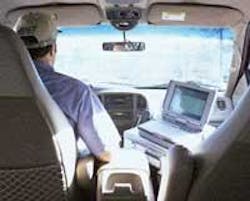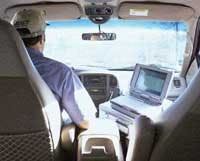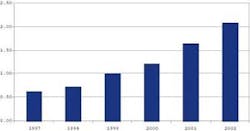AMR Business Case is Beoming More Compelling
By Donald L. Schlenger
An increasing number of water utilities are deciding that automatic meter reading (AMR) makes sense. As of the end of 2002, a total of about 7.3 million AMR units had been shipped to more than 3000 water utilities in the North America by more than a dozen different vendors. Most of these AMR systems employ mobile or fixed radio technology. AMR shipments to water utilities grew by more than 25% over 2001, despite tight utility budgets.
Utilities with more pressing needs or more straightforward business cases, as well as "early adopters," have implemented AMR for varied reasons. Consider the following three examples where utilities have looked to mobile radio AMR for a solution:
•The City of Houston experienced a 100% per year turnover in meter readers and needed to be less dependent on these staffing expenses;
•Denver Water wanted to increase its billing frequency, and its meters are sometimes covered by snow; and
•The County of Maui (HI) wanted to replace older water meters to increase registration and revenue without raising rates, and handle its increasing (and harder to reach) number of customers without increasing staff.
Other utilities are installing fixed radio AMR systems, including:
•Boston Water and Sewer Commission, where there was a need to increase its reading frequency to monthly to match its billing frequency, so that bills are always based on actual reads; and
•The District of Columbia Water and Sewer Authority, which had perennial problems accessing its meters.
It is notable that not only large utilities are deploying AMR. About 45% of all water AMR units in the North America have been installed by utilities with fewer than 25,000 connections. Many utilities, however, are still not able to justify the technology, and there certainly are legitimate hurdles: AMR is expensive, standards are lacking, and there are fears about obsolescence, overstated promises and vendor instability.
Yet there are compelling reasons for considering AMR. Over the last several years, AMR technology has grown more capable, cost effective and reliable. As utilities focus more on the bottom line and reduce staff, AMR can help fill the void. Moreover, it enables the radical process improvements that can leverage staff productivity, enhance customer service, and make the utility more competitive. As the industry better understands the value of the technology, AMR business cases have become more sophisticated—more benefits are being recognized and validated.
It is usually difficult to justify AMR based on meter reading alone. The full benefits are realized when the utility uses AMR as a tool to transform the way it serves customers. The key is to leverage the rich data that an AMR system can produce. As the utility's staff spends more time with the system, they discover additional ways to use it. In addition to reducing meter reading costs, utilities typically find major savings and benefits in reducing field and office customer service costs, reducing adjustments and increasing registration through changing old meters.
"The AMR system gives us a great deal of data with which to evaluate how our customers are using water," said Chuck Christensen, Supervisor of AMR at Des Moines Water Works, which is upgrading from an older telephone-based system that is getting harder to administer. "We can see if someone's usage takes a big jump or suddenly decreases. We can identify stopped meters relatively quickly."
The system also provides customer service representatives a tool to help customers with high bill concerns.
A big part of the AMR payback for Des Moines was a reduction in service calls for final reads and verification reads, as well as reduced meter reading costs.
"Some of the customer service benefits are hard to quantify, but their value was apparent to our board," said Christensen.
Value Beyond Cheaper Meter Reading
To minimize estimates, some utilities hold a billing cycle open for several days to allow time for field service representatives or customers to supply missed reads. However, this delays the receipt of revenues for water already delivered. With AMR, all of the customers in a cycle can be billed within hours of reading.
A second area of significant value, although often overlooked, is in estimated reads. Estimates are a nuisance to most utilities. Using AMR to eliminate most estimates reduces customer call volume and field visits, and when an occasional estimate is necessary (when an AMR device has failed or is temporarily blocked), it would not be problematic since it can be based on solid consumption history.
Progressive utilities can use their AMR data to improve the estimation formula by using a continuing analysis of consumption by class or type of customers (e.g., small-lot single-family residential) and total system production (to account for weather-related changes in consumption).
If the meter reading is high, then the customer can be proactively notified before he or she receives the bill, potentially reducing the number of calls and field visits and the number and size of bill adjustments. With AMR, it is often practical to read the meter more often then the customer is billed (for example, quarterly-billed customers can be read monthly), so customers can be notified well ahead.
If the consumption is abnormally low, then the consumption pattern has changed, there is a meter problem, or a diversion. Early identification of these conditions can reduce or eliminate service calls.
Driven by the need for meter reading reliability and good customer service, the City of Evanston, IL, bought a fixed radio AMR system to read its 14,500 accounts after outsourcing meter reading to the local gas utility.
"We were bothered by estimates and resulting calls from customers, some of which reached city council members," said Assistant Superintendent Regina Lookis, "but we didn't want to rehire meter readers; that would have been a step backwards. We wanted to integrate the meter reading function with meter service."
"When we see high consumption in the billing system, we proactively notify customers. To resolve a customer complaint about a high bill, we can reprogram the units to temporarily provide hourly readings," said Lookis.
Prior to AMR, Evanston staff spent an inordinate amount of time grappling with billing exceptions reports, and dispatching employees to reread meters. AMR has dramatically reduced the read-to-bill interval. Final bills have also been streamlined.
"Now, we can grab a current reading, and immediately calculate the bill for consumption since the last regular reading. This has dramatically reduced our collections effort," Lookis said.
Billing-related calls from customers have dropped by about 25% in the summer and as much as 50% during the rest of the year.
Reducing Adjustments
Some utilities will adjust the bill if a customer reports a leak and fixes it. However, the adjustment period can extend from the time the abnormal consumption could be discerned to the time the customer calls the utility to complain about the bill. Proactive high bill notification allows utilities to limit or eliminate adjustments. Even with liberal policies, the utility's obligation need not extend past the notification. Some AMR systems can provide "leak" alarms if, over a given time period, there is no interval during which consumption is zero.
Streamlining Reads
Initial and final meter reads when customers move are a major burden for many utilities, particularly where there is a lot of seasonal turnover (e.g., among college or resort communities and military populations). Customers may want a reading on closing day, but often fail to give the utility sufficient (or any) notice.
Some fixed radio AMR systems can deliver multiple readings each day to the utility's offices. At least one system will store hourly readings for two months, so that a field service representative could get the meter reading for a given day. Even the simplest systems can improve the utility's effectiveness: if it had an estimate-free consumption history for the account and a good estimation formula, the utility might be able to estimate or prorate the consumption to a given day while the customer is on the phone. If the utility could arrange payment at that time (i.e., by credit card) it would not have to "chase" the customer with final bills.
About the Author: Don Schlenger, Ph.D., is a Managing Partner with Cognyst Consulting. He can be reached at 973-838-8901 or by e-mail at [email protected].

